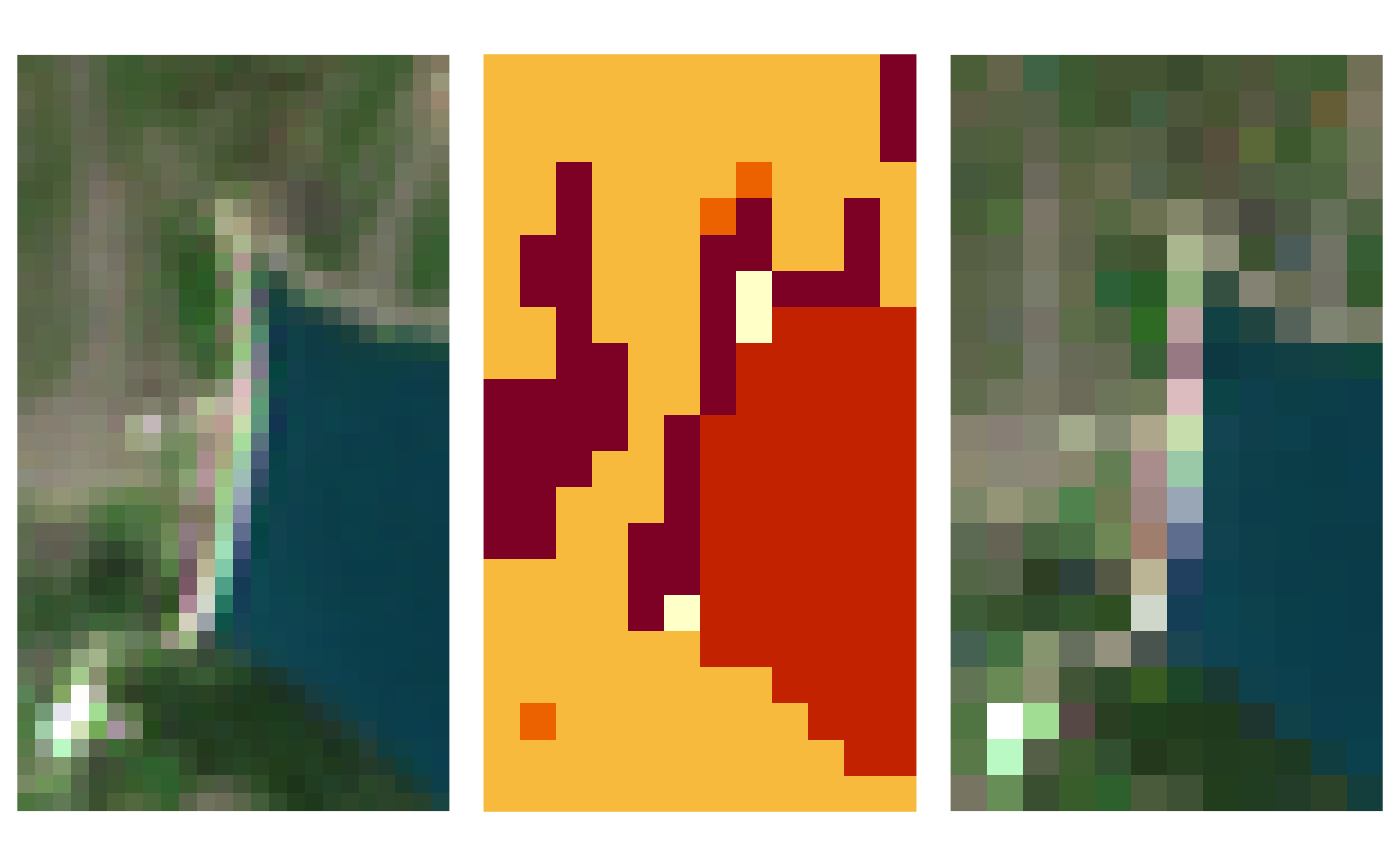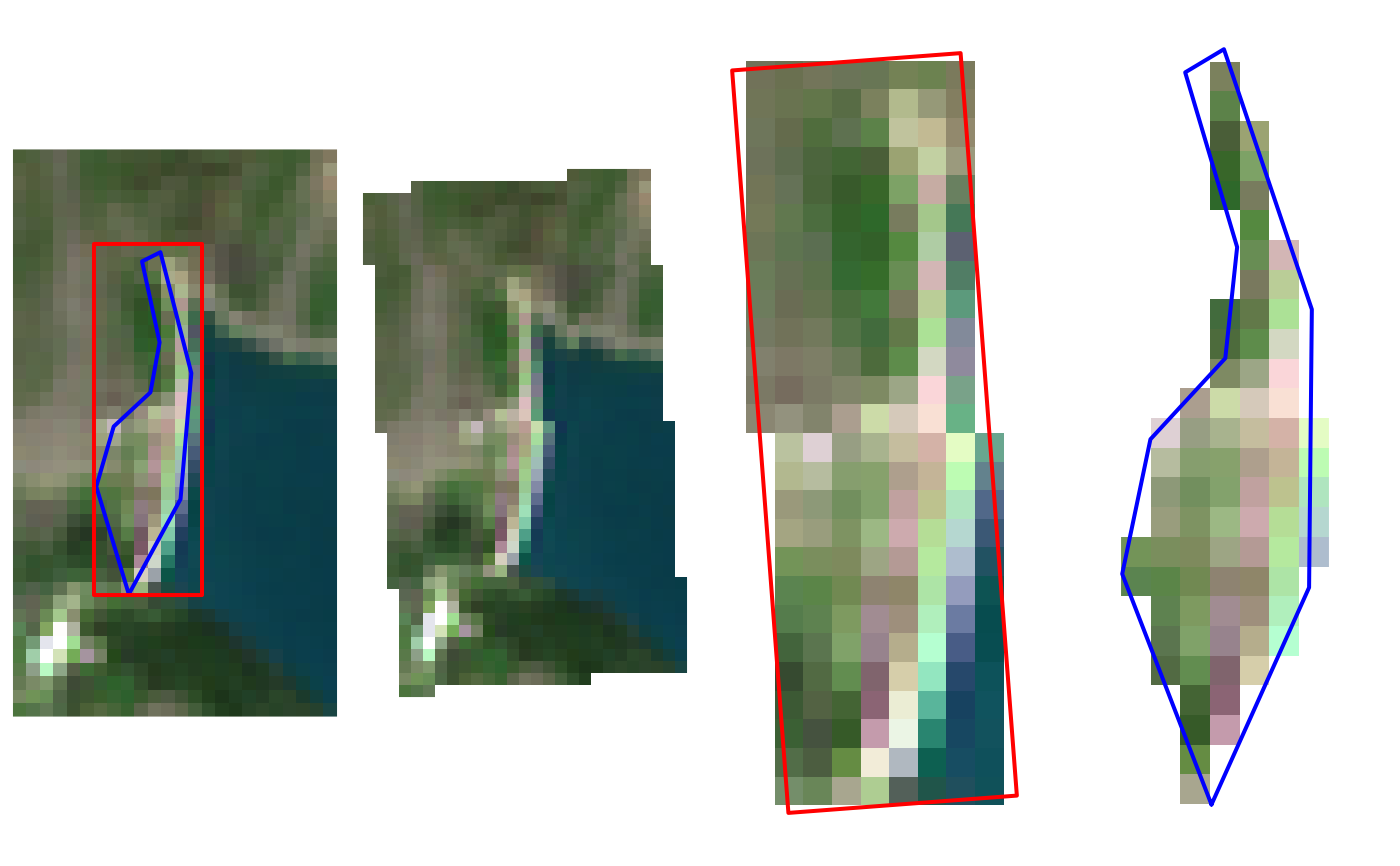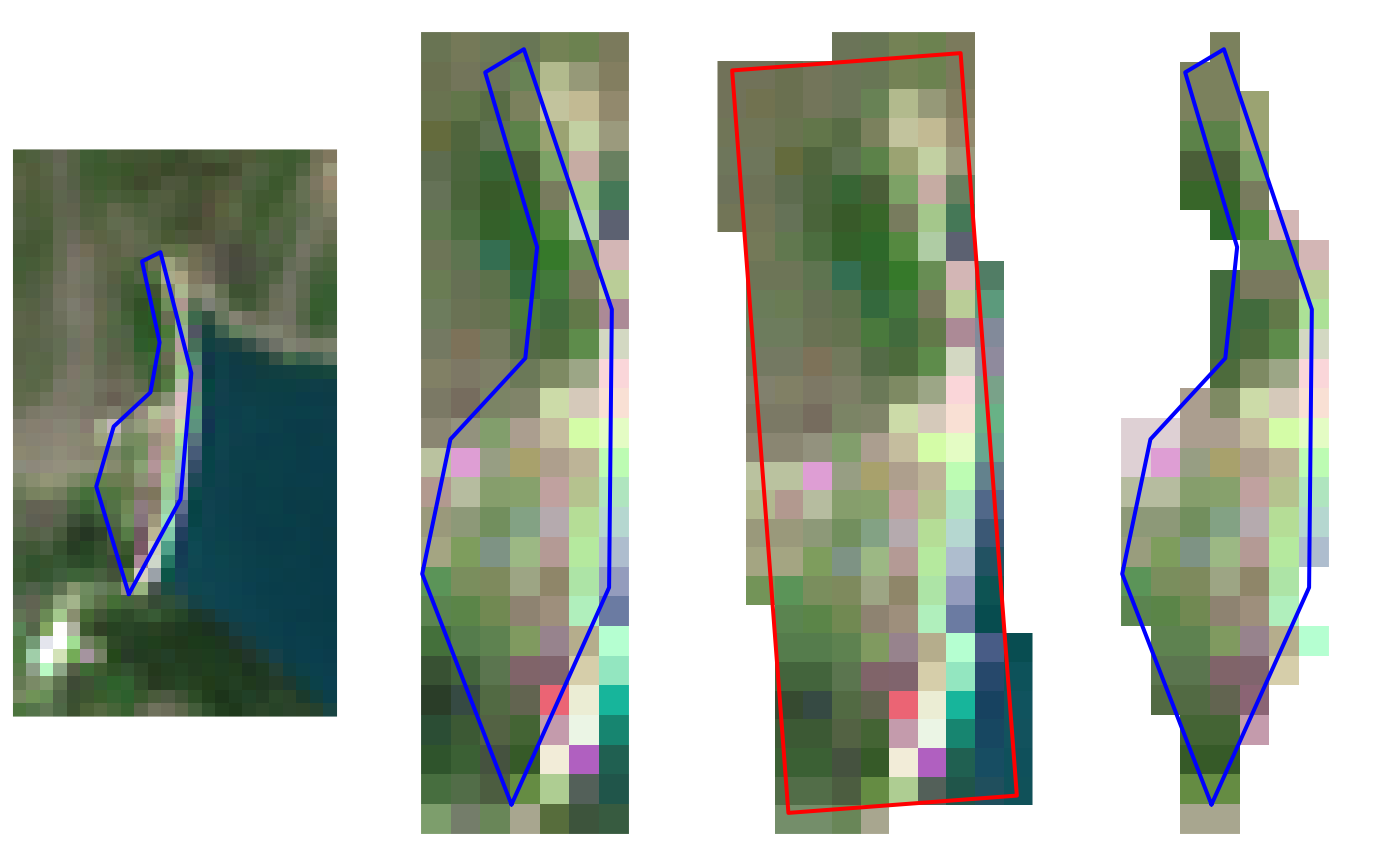The function applies gdalwarp
to clip, reproject and/or warp raster files.
If not specified, the output format of each file is the same of the
corresponding source file.
gdal_warp(
srcfiles,
dstfiles,
of = NULL,
co = NULL,
ref = NULL,
mask = NULL,
tr = NULL,
t_srs = NULL,
r = NULL,
dstnodata = NULL,
tap = FALSE,
overwrite = FALSE,
tmpdir = NA,
rmtmp = TRUE
)Arguments
- srcfiles
A vector of input file paths (managed by GDAL).
- dstfiles
A vector of corresponding output file paths.
- of
The output format (use the short format name). Default is the format of every input filename.
- co
Character. Passes a creation option to the output format driver. Multiple -co options may be listed. See format specific documentation for legal creation options for each format.
- ref
Path of the raster taken as reference: if provided, parameters regarding the output grid (alignment, resolution and extent) are taken from this raster. To set differently some of these values, specify also other values of
maskand/ortr.t_srsparameter value is always ignored whenrefis provided.- mask
Spatial path or object from which to take the extent of output files. If it is a polygon, this is used as masking layer; otherwise, only the bounding box is considered. If both
refandmaskare provided, this parameter will overlay the extent of the reference raster. In order to take only the grid fromresand not to clip on its extent, setmask=NA. Notice that the output projection is never taken frommask.- tr
Numeric. (
c(xres,yres)). set output file resolution (in target georeferenced units). If botrefandtrare provided,tris rounded in order to match the exact extent.- t_srs
Target spatial reference set (character). The coordinate systems that can be passed are anything supported by st_crs2.
- r
Resampling_method (
"near"|"bilinear"|"cubic"|"cubicspline"|"lanczos"|"average"|"mode"|"max"|"min"|"med"|"q1"|"q3").- dstnodata
Set nodata values for output bands (different values can be supplied for each band). If more than one value is supplied all values should be quoted to keep them together as a single operating system argument. New files will be initialized to this value and if possible the nodata value will be recorded in the output file. Use a value of NA to ensure that nodata is not defined. A vector with the same length of
srcfilescan be supplied, in order to specify different nodata values for each input file. If this argument is not used then nodata values will be copied from the source datasets. At the moment it is not possible to set different values for differentsrcfiles(use multiple calls of the functions).- tap
Logical (target aligned pixels) align the coordinates of the extent of the output file to the values of the
tr, such that the aligned extent includes the minimum extent. Default is FALSE.- overwrite
Logical value: should existing output files be overwritten? (default: FALSE)
- tmpdir
(optional) Path where intermediate files (maskfile) will be created. Default is a temporary directory. If
tmpdiris a non-empty folder, a random subdirectory will be used.- rmtmp
(optional) Logical: should temporary files be removed? (Default: TRUE)
Value
NULL (the function is called for its side effects)
Note
License: GPL 3.0
References
L. Ranghetti, M. Boschetti, F. Nutini, L. Busetto (2020). "sen2r": An R toolbox for automatically downloading and preprocessing Sentinel-2 satellite data. Computers & Geosciences, 139, 104473. doi:10.1016/j.cageo.2020.104473 , URL: https://sen2r.ranghetti.info/.
Examples
# \donttest{
#' # Define file names
ex_sel <- system.file(
"extdata/out/S2A2A_20190723_022_Barbellino_RGB432B_10.tif",
package = "sen2r"
)
ex_ref <- system.file(
"extdata/out/S2A2A_20190723_022_Barbellino_SCL_10.tif",
package = "sen2r"
)
crop_poly <- system.file("extdata/vector/dam.geojson", package = "sen2r")
crop_line <- sf::st_cast(sf::read_sf(crop_poly), "LINESTRING")
# Simple clip
test1 <- tempfile(fileext = "_test1.tif")
gdal_warp(ex_sel, test1, mask = crop_line)
# Clip and mask
test2 <- tempfile(fileext = "_test2.tif")
gdal_warp(ex_sel, test2, mask = crop_poly)
# Show output
crop_bbox <- sf::st_as_sfc(sf::st_bbox(crop_line))
oldpar <- par(mfrow = c(1,3), mar = rep(0,4))
image(stars::read_stars(ex_sel), rgb = 1:3, useRaster = TRUE)
plot(crop_line, add = TRUE, col = "blue", lwd = 2)
plot(crop_bbox, add = TRUE, border = "red", lwd = 2)
image(stars::read_stars(test1), rgb = 1:3, useRaster = TRUE)
plot(crop_bbox, add = TRUE, border = "red", lwd = 2)
image(stars::read_stars(test2), rgb = 1:3, useRaster = TRUE)
plot(crop_line, add = TRUE, col = "blue", lwd = 2)
 # Warp on a reference raster
test3 <- tempfile(fileext = "_test3.tif")
gdal_warp(ex_sel, test3, ref = ex_ref)
# Show output
par(mfrow = c(1,3))
par(mar = rep(0,4)); image(stars::read_stars(ex_sel), rgb = 1:3, useRaster = TRUE)
par(mar = rep(2/3,4)); image(stars::read_stars(ex_ref), useRaster = TRUE)
par(mar = rep(0,4)); image(stars::read_stars(test3), rgb = 1:3, useRaster = TRUE)
# Warp on a reference raster
test3 <- tempfile(fileext = "_test3.tif")
gdal_warp(ex_sel, test3, ref = ex_ref)
# Show output
par(mfrow = c(1,3))
par(mar = rep(0,4)); image(stars::read_stars(ex_sel), rgb = 1:3, useRaster = TRUE)
par(mar = rep(2/3,4)); image(stars::read_stars(ex_ref), useRaster = TRUE)
par(mar = rep(0,4)); image(stars::read_stars(test3), rgb = 1:3, useRaster = TRUE)
 # Reproject all the input file
test4 <- tempfile(fileext = "_test4.tif")
gdal_warp(ex_sel, test4, t_srs = 32631)
# Reproject and clip on a bounding box
test5 <- tempfile(fileext = "_test5.tif")
gdal_warp(ex_sel, test5, t_srs = "EPSG:32631", mask = stars::read_stars(test1))
# Reproject and clip on polygon (masking outside)
test6 <- tempfile(fileext = "_test6.tif")
gdal_warp(ex_sel, test6, t_srs = "31N", mask = crop_poly)
# Show output
crop_line_31N <- sf::st_transform(crop_line, 32631)
test1_bbox <- sf::st_as_sfc(sf::st_bbox(stars::read_stars(test1)))
test1_bbox_31N <- sf::st_transform(test1_bbox, 32631)
par(mfrow = c(1,4), mar = rep(0,4))
image(stars::read_stars(ex_sel), rgb = 1:3, useRaster = TRUE)
plot(crop_line, add = TRUE, col = "blue", lwd = 2)
plot(test1_bbox, add = TRUE, border = "red", lwd = 2)
image(stars::read_stars(test4), rgb = 1:3, useRaster = TRUE)
image(stars::read_stars(test5), rgb = 1:3, useRaster = TRUE)
plot(test1_bbox_31N, add = TRUE, border = "red", lwd = 2)
image(stars::read_stars(test6), rgb = 1:3, useRaster = TRUE)
plot(crop_line_31N, add = TRUE, col = "blue", lwd = 2)
# Reproject all the input file
test4 <- tempfile(fileext = "_test4.tif")
gdal_warp(ex_sel, test4, t_srs = 32631)
# Reproject and clip on a bounding box
test5 <- tempfile(fileext = "_test5.tif")
gdal_warp(ex_sel, test5, t_srs = "EPSG:32631", mask = stars::read_stars(test1))
# Reproject and clip on polygon (masking outside)
test6 <- tempfile(fileext = "_test6.tif")
gdal_warp(ex_sel, test6, t_srs = "31N", mask = crop_poly)
# Show output
crop_line_31N <- sf::st_transform(crop_line, 32631)
test1_bbox <- sf::st_as_sfc(sf::st_bbox(stars::read_stars(test1)))
test1_bbox_31N <- sf::st_transform(test1_bbox, 32631)
par(mfrow = c(1,4), mar = rep(0,4))
image(stars::read_stars(ex_sel), rgb = 1:3, useRaster = TRUE)
plot(crop_line, add = TRUE, col = "blue", lwd = 2)
plot(test1_bbox, add = TRUE, border = "red", lwd = 2)
image(stars::read_stars(test4), rgb = 1:3, useRaster = TRUE)
image(stars::read_stars(test5), rgb = 1:3, useRaster = TRUE)
plot(test1_bbox_31N, add = TRUE, border = "red", lwd = 2)
image(stars::read_stars(test6), rgb = 1:3, useRaster = TRUE)
plot(crop_line_31N, add = TRUE, col = "blue", lwd = 2)
 # Use a reference raster with a different projection
test7 <- tempfile(fileext = "_test7.tif")
gdal_warp(ex_sel, test7, ref = test6)
# Use a reference raster with a different projection
# and specify a different bounding box
test8 <- tempfile(fileext = "_test8.tif")
gdal_warp(ex_sel, test8, mask = stars::read_stars(test1), ref = test6)
# Use a reference raster with a different projection and a mask
test9 <- tempfile(fileext = "_test9.tif")
gdal_warp(ex_sel, test9, mask = crop_poly, ref = test6)
# Show output
par(mfrow = c(1,4), mar = rep(0,4))
image(stars::read_stars(ex_sel), rgb = 1:3, useRaster = TRUE)
plot(crop_line, add = TRUE, col = "blue", lwd = 2)
image(stars::read_stars(test7), rgb = 1:3, useRaster = TRUE)
plot(crop_line_31N, add = TRUE, col = "blue", lwd = 2)
image(stars::read_stars(test8), rgb = 1:3, useRaster = TRUE)
plot(test1_bbox_31N, add = TRUE, border = "red", lwd = 2)
image(stars::read_stars(test9), rgb = 1:3, useRaster = TRUE)
plot(crop_line_31N, add = TRUE, col = "blue", lwd = 2)
# Use a reference raster with a different projection
test7 <- tempfile(fileext = "_test7.tif")
gdal_warp(ex_sel, test7, ref = test6)
# Use a reference raster with a different projection
# and specify a different bounding box
test8 <- tempfile(fileext = "_test8.tif")
gdal_warp(ex_sel, test8, mask = stars::read_stars(test1), ref = test6)
# Use a reference raster with a different projection and a mask
test9 <- tempfile(fileext = "_test9.tif")
gdal_warp(ex_sel, test9, mask = crop_poly, ref = test6)
# Show output
par(mfrow = c(1,4), mar = rep(0,4))
image(stars::read_stars(ex_sel), rgb = 1:3, useRaster = TRUE)
plot(crop_line, add = TRUE, col = "blue", lwd = 2)
image(stars::read_stars(test7), rgb = 1:3, useRaster = TRUE)
plot(crop_line_31N, add = TRUE, col = "blue", lwd = 2)
image(stars::read_stars(test8), rgb = 1:3, useRaster = TRUE)
plot(test1_bbox_31N, add = TRUE, border = "red", lwd = 2)
image(stars::read_stars(test9), rgb = 1:3, useRaster = TRUE)
plot(crop_line_31N, add = TRUE, col = "blue", lwd = 2)
 par(oldpar)
# }
par(oldpar)
# }